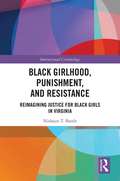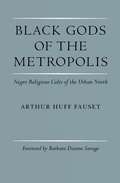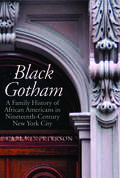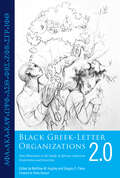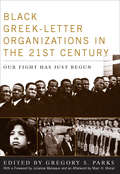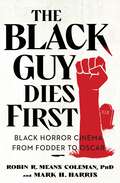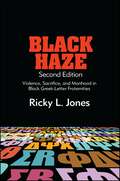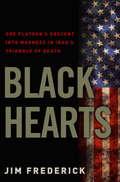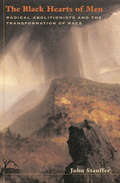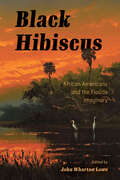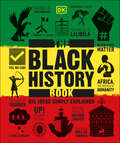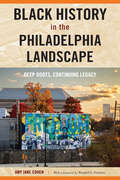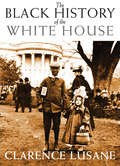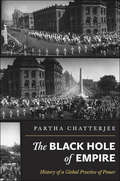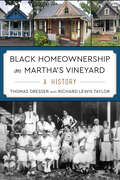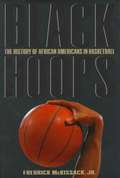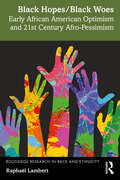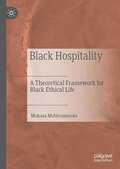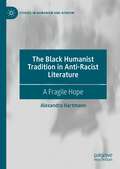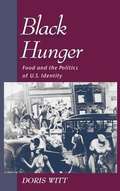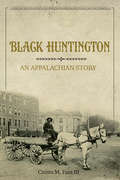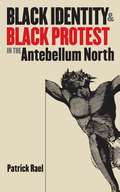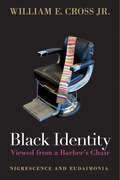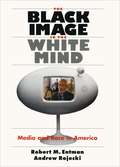- Table View
- List View
Black Girlhood, Punishment, and Resistance: Reimagining Justice for Black Girls in Virginia (Intersectional Criminology)
by Nishaun T. BattleBlack Girlhood, Punishment, and Resistance: Reimagining Justice for Black Girls in Virginia provides a historical comprehensive examination of racialized, classed, and gendered punishment of Black girls in Virginia during the early twentieth century. It looks at the ways in which the court system punished Black girls based upon societal accepted norms of punishment, hinged on a notion that they were to be viewed and treated as adults within the criminal legal system. Further, the book explores the role of Black Club women and girls as agents of resistance against injustice by shaping a social justice framework and praxis for Black girls and by examining the establishment of the Virginia Industrial School for Colored Girls. This school was established by the Virginia State Federation of Colored Women’s Clubs and its first President, Janie Porter Barrett. This book advances contemporary criminological understanding of punishment by locating the historical origins of an environment normalizing unequal justice. It draws from a specific focus on Janie Porter Barrett and the Virginia Industrial School for Colored Girls; a groundbreaking court case of the first female to be executed in Virginia; historical newspapers; and Black Women’s Club archives to highlight the complexities of Black girls’ experiences within the criminal justice system and spaces created to promote social justice for these girls. The historical approach unearths the justice system’s role in crafting the pervasive devaluation of Black girlhood through racialized, gendered, and economic-based punishment. Second, it offers insight into the ways in which, historically, Black women have contributed to what the book conceptualizes as “resistance criminology,” offering policy implications for transformative social and legal justice for Black girls and girls of color impacted by violence and punishment. Finally, it offers a lens to explore Black girl resistance strategies, through the lens of the Black Girlhood Justice framework. Black Girlhood, Punishment, and Resistance uses a historical intersectionality framework to provide a comprehensive overview of cultural, socioeconomic, and legal infrastructures as they relate to the punishment of Black girls. The research illustrates how the presumption of guilt of Black people shaped the ways that punishment and the creation of deviant Black female identities were legally sanctioned. It is essential reading for academics and students researching and studying crime, criminal justice, theoretical criminology, women’s studies, Black girlhood studies, history, gender, race, and socioeconomic class. It is also intended for social justice organizations, community leaders, and activists engaged in promoting social and legal justice for the youth.
Black Gods of the Metropolis
by Barbara Dianne Savage John Szwed Arthur Huff FausetStemming from his anthropological field work among black religious groups in Philadelphia in the early 1940s, Arthur Huff Fauset believed it was possible to determine the likely direction that mainstream black religious leadership would take in the future, a direction that later indeed manifested itself in the civil rights movement. The American black church, according to Fauset and other contemporary researchers, provided the one place where blacks could experiment without hindrance in activities such as business, politics, social reform, and social expression. With detailed primary accounts of these early spiritual movements and their beliefs and practices, Black Gods of the Metropolis reveals the fascinating origins of such significant modern African American religious groups as the Nation of Islam as well as the role of lesser known and even forgotten churches in the history of the black community.In her new foreword, historian Barbara Dianne Savage discusses the relationship between black intellectuals and black religion, in particular the relationship between black social scientists and black religious practices during Fauset's time. She then explores the complexities of that relationship and its impact on the intellectual and political history of African American religion in general.
Black Gotham
by Carla L. PetersonPart detective tale, part social and cultural narrative,Black Gothamis Carla Peterson's riveting account of her quest to reconstruct the lives of her nineteenth-century ancestors. As she shares their stories and those of their friends, neighbors, and business associates, she illuminates the greater history of African-American elites in New York City. Black Gothamchallenges many of the accepted "truths" about African-American history, including the assumption that the phrase "nineteenth-century black Americans" means enslaved people, that "New York state before the Civil War" refers to a place of freedom, and that a black elite did not exist until the twentieth century. Beginning her story in the 1820s, Peterson focuses on the pupils of the Mulberry Street School, the graduates of which went on to become eminent African-American leaders. She traces their political activities as well as their many achievements in trade, business, and the professions against the backdrop of the expansion of scientific racism, the trauma of the Civil War draft riots, and the rise of Jim Crow. Told in a vivid, fast-paced style,Black Gothamis an important account of the rarely acknowledged achievements of nineteenth-century African Americans and brings to the forefront a vital yet forgotten part of American history and culture.
Black Greek-Letter Organizations 2.0: New Directions in the Study of African American Fraternities and Sororities
by Matthew W. Hughey Gregory S. ParksAt the turn of the twentieth century, black fraternities and sororities, also known as Black Greek-Letter Organizations (BGLOs), were an integral part of what W.E.B. Du Bois called the “talented tenth.” This was the top ten percent of the black community that would serve as a cadre of educated, upper-class, motivated individuals who acquired the professional credentials, skills, and capital to assist the race to attain socioeconomic parity. Today, however, BGLOs struggle to find their place and direction in a world drastically different from the one that witnessed their genesis. In recent years, there has been a growing body of scholarship on BGLOs. This collection of essays seeks to push those who think about BGLOs to engage in more critically and empirically based analysis. This book also seeks to move BGLO members and those who work with them beyond conclusions based on hunches, conventional wisdom, intuition, and personal experience. In addition to a rich range of scholars, this volume includes a kind of call and response feature between scholars and prominent members of the BGLO community.
Black Greek-Letter Organizations in the 21st Century: Our Fight Has Just Begun
by Marc H. Morial“A masterpiece of multidisciplinary scholarship that clearly demonstrates the contemporary relevance of black fraternities and sororities.” —Hasan Kwame Jeffries, author of Bloody LowndesDuring the twentieth century, black Greek-Letter organizations (BGLOs) united college students dedicated to excellence, fostered kinship, and uplifted African Americans. Members of these organizations include remarkable and influential individuals such as Martin Luther King Jr., Congresswoman Barbara Jordan, novelist Toni Morrison, and Wall Street pioneer Reginald F. Lewis. Despite the profound influence of these groups, many now question the continuing relevance of BGLOs, arguing that their golden age has passed.To foster a greater engagement with the history and contributions of BGLOs, Black Greek-Letter Organizations in the Twenty-first Century brings together an impressive group of authors to explore the contributions and continuing possibilities of BGLOs and their members. Editor Gregory S. Parks and the contributing authors provide historical context for the development of BGLOs, exploring their service activities as well as their relationships with other prominent African American institutions. Both internally and externally, BGLOs struggle to forge a relevant identity for the new century. Internally, these groups wrestle with many issues, including hazing, homophobia, petty intergroup competition, and the difficulty of bridging the divide between college and alumni members. Externally, BGLOs face the challenge of rededicating themselves to their communities and leading an aggressive campaign against modern forms of racism, sexism, and other types of fear-driven behavior.By embracing the history of these organizations and exploring their continuing viability and relevance, Black Greek-Letter Organizations in the Twenty-first Century demonstrates that BGLOs can create a positive and enduring future and that their most important work lies ahead.
The Black Guy Dies First: Black Horror Cinema from Fodder to Oscar
by Robin R. Means Coleman Mark H. HarrisA definitive and surprising exploration of the history of Black horror films, after the rising success of Get Out, Candyman, and Lovecraft Country from creators behind the acclaimed documentary, Horror Noire.The Black Guy Dies First explores the Black journey in modern horror cinema, from the fodder epitomized by Spider Baby to the Oscar-winning cinematic heights of Get Out and beyond. This eye-opening book delves into the themes, tropes, and traits that have come to characterize Black roles in horror since 1968, a year in which race made national headlines in iconic moments from the enactment of the 1968 Civil Rights Act and Martin Luther King Jr.&’s assassination in April. This timely book is a must-read for cinema and horror fans alike.
Black Haze, Second Edition: Violence, Sacrifice, and Manhood in Black Greek-Letter Fraternities (SUNY series in African American Studies)
by Ricky L. JonesAre black men naturally violent? Do they define manhood in the same way as their counterparts across lines of race? Are black Greek-letter fraternities among the most dangerous student organizations on American college and university campuses? Can their often-dangerous initiation processes be stopped or even modified and, if not, what should be done about them? In this second edition of Black Haze, Ricky L. Jones takes on these questions and more. The first edition was an enlightening and sometimes disturbing examination of American men's quest for acceptance, comfort, reaffirmation, and manhood in a world where their footing is often unstable. In this new edition Jones not only provides masterful philosophical and ethical analyses but he also forces the engagement of a terrifying real world process that damages and kills students with all too frequent regularity. With a revealing new preface and stunning afterword, Jones immerses the reader in an intriguing and dark world marked by hypermasculinity, unapologetic brutality, and sometimes death. He offers a compelling book that ranges well beyond the subject of hazing—one that yields perplexing questions and demands difficult choices as we move forward in addressing issues surrounding fraternities, violent hazing, black men, and American society.
Black Hearts: One Platoon's Descent into Madness in Iraq's Triangle of Death
by Jim FrederickThis is the story of a small group of soldiers from the 101st Airborne Division's fabled 502nd Infantry Regiment--a unit known as "the Black Heart Brigade." Deployed in late 2005 to Iraq's so-called Triangle of Death, a veritable meat grinder just south of Baghdad, the Black Hearts found themselves in arguably the country's most dangerous location at its most dangerous time. Hit by near-daily mortars, gunfire, and roadside bomb attacks, suffering from a particularly heavy death toll, and enduring a chronic breakdown in leadership, members of one Black Heart platoon--1st Platoon, Bravo Company, 1st Battalion--descended, over their year-long tour of duty, into a tailspin of poor discipline, substance abuse, and brutality.Four 1st Platoon soldiers would perpetrate one of the most heinous war crimes U.S. forces have committed during the Iraq War--the rape of a fourteen-year-old Iraqi girl and the cold-blooded execution of her and her family. Three other 1st Platoon soldiers would be overrun at a remote outpost--one killed immediately and two taken from the scene, their mutilated corpses found days later booby-trapped with explosives.Black Hearts is an unflinching account of the epic, tragic deployment of 1st Platoon. Drawing on hundreds of hours of in-depth interviews with Black Heart soldiers and first-hand reporting from the Triangle of Death, Black Hearts is a timeless story about men in combat and the fragility of character in the savage crucible of warfare. But it is also a timely warning of new dangers emerging in the way American soldiers are led on the battlefields of the twenty-first century.From the Hardcover edition.
The Black Hearts of Men: Radical Abolitionists and the Transformation of Race
by John StaufferAt a time when slavery was spreading and the country was steeped in racism, two white men and two black men overcame social barriers and mistrust to form a unique alliance that sought nothing less than the end of all evil. Drawing on the largest extant bi-racial correspondence in the Civil War era, John Stauffer braids together these men's struggles to reconcile ideals of justice with the reality of slavery and oppression. Who could imagine that Gerrit Smith, one of the richest men in the country, would give away his wealth to the poor and ally himself with Frederick Douglass, an ex-slave? And why would James McCune Smith, the most educated black man in the country, link arms with John Brown, a bankrupt entrepreneur, along with the others? Distinguished by their interracial bonds, they shared a millennialist vision of a new world where everyone was free and equal. As the nation headed toward armed conflict, these men waged their own war by establishing model interracial communities, forming a new political party, and embracing violence. Their revolutionary ethos bridged the divide between the sacred and the profane, black and white, masculine and feminine, and civilization and savagery that had long girded western culture. In so doing, it embraced a malleable and "black-hearted" self that was capable of violent revolt against a slaveholding nation, in order to usher in a kingdom of God on earth. In tracing the rise and fall of their prophetic vision and alliance, Stauffer reveals how radical reform helped propel the nation toward war even as it strove to vanquish slavery and preserve the peace.
Black Hibiscus: African Americans and the Florida Imaginary
by John Wharton LoweContributions by Simone A. James Alexander, José Felipe Alvergue, Valerie Babb, Pamela Bordelon, Taylor Hagood, Joyce Marie Jackson, Delia Malia Konzett, Jane Landers, John Wharton Lowe, Gary Monroe, Noelle Morrissette, Paul Ortiz, Lyrae Van Clief-Stefanon, Genevieve West, and Belinda Wheeler The state of Florida has a rich literary and cultural history, which has been greatly shaped by many different ethnicities, races, and cultures that call the Sunshine State home. Little attention has been paid, however, to the key role of African Americans in Floridian history and culture. The state’s early population boom came from immigrants from the US South, and many of them were African Americans. Interaction between the state’s ethnic communities has created a unique and vibrant culture, which has had, and continues to have, a significant impact on southern, national, and hemispheric life and history. Black Hibiscus: African Americans and the Florida Imaginary begins by exploring Florida’s colonial past, focusing particularly on interactions between maroons who escaped enslavement, and on Albery Whitman’s The Rape of Florida, which also links Black people and Native Americans. Contributors consider film, folklore, and music, as well as such key Black writers as Zora Neale Hurston, James Weldon Johnson, Gwendolyn Bennett, Colson Whitehead, and Edwidge Danticat. The volume features Black Floridians’ role in the civil rights movement and Black contributions to the celebrated Florida Writers’ Project. Contributors include literary scholars, historians, film critics, art historians, anthropologists, musicologists, political scientists, artists, and poets.
The Black History Book: Big Ideas Simply Explained (DK Big Ideas)
by DKLearn about the most important milestones in Black history in The Black History Book.Part of the fascinating Big Ideas series, this book tackles tricky topics and themes in a simple and easy to follow format. Learn about Black History in this overview guide to the subject, great for novices looking to find out more and experts wishing to refresh their knowledge alike! The Black History Book brings a fresh and vibrant take on the topic through eye-catching graphics and diagrams to immerse yourself in. This captivating book will broaden your understanding of Black History, with:- Covers the most important milestones in Black and African history- Packed with facts, charts, timelines and graphs to help explain core concepts- A visual approach to big subjects with striking illustrations and graphics throughout- Easy to follow text makes topics accessible for people at any level of understandingThe Black History Book is a captivating introduction to the key milestones in Black History, culture, and society across the globe – from the ancient world to the present, aimed at adults with an interest in the subject and students wanting to gain more of an overview. Explore the rich history of the peoples of Africa and the African diaspora, and the struggles and triumphs of Black communities around the world, all through engaging text and bold graphics.Your Black History Questions, Simply ExplainedWhich were the most powerful African empires? Who were the pioneers of jazz? What sparked the Black Lives Matter movement? If you thought it was difficult to learn about the legacy of African-American history, The Black History Book presents crucial information in an easy to follow layout. Learn about the earliest human migrations to modern Black communities, stories of the early kingdoms of Ancient Egypt and Nubia; the powerful medieval and early modern empires; and the struggle against colonization. This book also explores Black history beyond the African continent, like the Atlantic slave trade and slave resistance settlements; the Harlem Renaissance and Jazz Age; the Windrush migration; civil rights and Black feminist movements.The Big Ideas SeriesWith millions of copies sold worldwide, The Black History Book is part of the award-winning Big Ideas series from DK. The series uses striking graphics along with engaging writing, making big topics easy to understand.
Black History in the Philadelphia Landscape: Deep Roots, Continuing Legacy
by Amy Jane CohenBlack Philadelphians have shaped Philadelphia history since colonial times. In Black History in the Philadelphia Landscape, Amy Cohen recounts notable aspects of the Black experience in Philadelphia from the late 1600s to the 1960s and how this history is marked in the contemporary city. She charts Charles Blockson’s efforts to commemorate the Pennsylvania slave trade with a historical marker and highlights Richard Allen, who founded Mother Bethel A.M.E. Church. Cohen also describes the path to erecting a statue of civil rights activist Octavius Catto at Philadelphia’s City Hall and profiles international celebrities Marian Anderson and Paul Robeson who are honored in the city. At the end of each chapter, she includes suggestions to continue readers’ exploration of this important cultural heritage. Showing how increased attention to the role of African Americans in local and national history has resulted in numerous, sometimes controversial, alterations to the landscape, Cohen guides readers to Black history’s significance and its connections with today’s spotlight on racial justice.
The Black History of the White House
by Clarence Lusane"Clarence Lusane is one of America's most thoughtful and critical thinkers on issues of race, class and power."-Manning Marable"Barack Obama may be the first black president in the White House, but he's far from the first black person to work in it. In this fascinating history of all the enslaved people, workers and entertainers who spent time in the president's official residence over the years, Clarence Lusane restores the White House to its true colors." --Barbara EhrenreichThe Black History of the White House presents the untold history, racial politics, and shifting significance of the White House as experienced by African Americans, from the generations of enslaved people who helped to build it or were forced to work there to its first black First Family, the Obamas.Clarence Lusane juxtaposes significant events in White House history with the ongoing struggle for democratic, civil, and human rights by black Americans and demonstrates that only during crises have presidents used their authority to advance racial justice. He describes how in 1901 the building was officially named the "White House" amidst a furious backlash against President Roosevelt for inviting Booker T. Washington to dinner, and how that same year that saw the consolidation of white power with the departure of the last black Congressmember elected after the Civil War. Lusane explores how, from its construction in 1792 to its becoming the home of the first black president, the White House has been a prism through which to view the progress and struggles of black Americans seeking full citizenship and justice.Dr. Clarence Lusane has published in The Washington Post, The Miami Herald, The Baltimore Sun, Oakland Tribune, Black Scholar, and Race and Class. He often appears on PBS, BET, C-SPAN, and other national media.
The Black Hole of Empire: History of a Global Practice of Power
by Partha ChatterjeeWhen Siraj, the ruler of Bengal, overran the British settlement of Calcutta in 1756, he allegedly jailed 146 European prisoners overnight in a cramped prison. Of the group, 123 died of suffocation. While this episode was never independently confirmed, the story of "the black hole of Calcutta" was widely circulated and seen by the British public as an atrocity committed by savage colonial subjects. The Black Hole of Empire follows the ever-changing representations of this historical event and founding myth of the British Empire in India, from the eighteenth century to the present. Partha Chatterjee explores how a supposed tragedy paved the ideological foundations for the "civilizing" force of British imperial rule and territorial control in India. Chatterjee takes a close look at the justifications of modern empire by liberal thinkers, international lawyers, and conservative traditionalists, and examines the intellectual and political responses of the colonized, including those of Bengali nationalists. The two sides of empire's entwined history are brought together in the story of the Black Hole memorial: set up in Calcutta in 1760, demolished in 1821, restored by Lord Curzon in 1902, and removed in 1940 to a neglected churchyard. Challenging conventional truisms of imperial history, nationalist scholarship, and liberal visions of globalization, Chatterjee argues that empire is a necessary and continuing part of the history of the modern state.
Black Homeownership on Martha's Vineyard: A History
by Thomas Dresser Richard Lewis TaylorMartha's Vineyard has always been a unique island and vacation destination, made even more diverse with the arrival of Black homeowners in the 19th century. Early landowners included the formerly enslaved Charles Shearer, who along with his wife Henrietta, founded Shearer Cottage. However, the fall of the first Black community on the island came in the 1890s when forty Black and Indigenous people were required to remove their cottages from the Martha's Vineyard Camp Meeting Association. Despite this painful blow, other families, including the Wests, Jones and Huberts bought island homes, challenging restrictive and racist covenants that encumbered the properties. They then passed their homes on to subsequent generations, leading to a legacy of Black homeownership that thrives to this day. Authors Thomas Dresser and Richard Taylor explore the challenges, triumphs and the sense of community that has endured.
Black Hoops: The History of African Americans in Basketball
by Fredrick L. MckissackThis exciting, well-researched book explores the evolution of basketball with a focus on the black athletes and history-making teams that have shaped the game every step of the way -- from its humble beginnings in 1891 to the superstar sport it is today.
Black Hopes/Black Woes: Early African American Optimism and 21st Century Afro-Pessimism (Routledge Research in Race and Ethnicity)
by Raphaël LambertBlack Hopes/Black Woes begins by delving into the contrasting mindsets of postbellum African Americans and their twenty-first-century counterparts, aiming to elucidate the shift from early Black optimism to present-day Black pessimism. It then focuses on the rationale behind Afro-pessimism, a contemporary school of thought with an inconspicuous yet potent influence on mainstream culture.The first part of the book focuses on Frederick Douglass’s and WEB Du Bois’s interpretations of slave songs, establishing a link between the Negro, freedom, and democracy. This optimistic view is juxtaposed with Saidiya Hartman’s, who, with 100 years’ hindsight, condemns Du Bois’s reformist spirit and efforts to tackle Black poverty as supercilious and damaging. The book then scrutinizes Afro-pessimism through the work of Frank B. Wilderson III, who posits that the stability of civil society hinges on anti-Black violence. Accordingly, he argues that any analogy between Black and non-Black experiences is flawed and that Marxism, which privileges labor over racial issues, is inadequate to grasp Blackness. Additionally, the book explores the essentialist discourse of Afro-pessimism through David Marriott’s analysis of Frantz Fanon, which theorizes the non-beingness of Blackness despite Fanon’s focus on being colonized rather than Black. Finally, the book demonstrates how Afro-pessimism overlaps with postcolonialism and conflicts with Fanon’s universalism, his rejection of identity politics, and his advocacy for transracial and transnational dialogue.While the radical nature of Afro-pessimism may seem to manifest an unresolved national trauma, Black Hopes/Black Woes situates this ideology in the larger contemporary philosophical and critical discourse, shedding light on its propensity to foster a culture of resentment and cynicism. Once confined to a niche academic audience, Afro-pessimism has percolated the mainstream, stoking the fire of racial antagonism.
Black Hospitality: A Theoretical Framework for Black Ethical Life
by Mukasa MubirumusokeThis book addresses the paucity of robust reflections on ethics as a distinct field of experience in recent Black Studies scholarship. Following the intervention of the Afro-Pessimist school of thought—spearheaded by the likes of Frank Wilderson III and Jared Sexton—there has been much needed attention brought to the totalizing nature of Black political degradation and vulnerability in America. However, an in depth reflection on the ethical implications of this political positionality is lacking and in places even implied to not be possible. Black Hospitality conceptualizes what the author argues is the aporetic experience of Black ethical life as both excessively vulnerable within and yet also ultimately hostile to an anti-black political ontology. Engaging the work of scholars such as Fred Moten, Saidiya Hartman, Nahum Chandler, Jacques Derrida, Theodor Adorno, and Toni Morrison, along with the concepts of fugitivity, Black sociality, im-possibility, and paraontology, Black Hospitality insists that Black ethical life provides a necessary broadening of the contours of Black experience.
The Black Humanist Tradition in Anti-Racist Literature: A Fragile Hope (Studies in Humanism and Atheism)
by Alexandra HartmannThis book presents an intellectual history and theoretical exploration of black humanism since the civil rights era. Humanism is a human-centered approach to life that considers human beings to be responsible for the world and its course of history. Both the heavily theistic climate in the United States as well as the dominance of the Black Church are responsible for black humanism’s existence in virtual oblivion. For those who believe the world to be one without supernatural interventions, human action matters greatly and is the only possible mode for change. Humanists are thus committed to promoting the public good through human effort rather than through faith. Black humanism originates from the lived experiences of African Americans in a white hegemonic society. Viewed from this perspective, black humanist cultural expressions are a continuous push to imagine and make room for alternative life options in a racist society. Alexandra Hartmann counters religion’s hegemonic grasp and uncovers black humanism as a small yet significant tradition in recent African American culture and cultural politics by studying its impact on African American literature and the ensuing anti-racist potentials. The book demonstrates that black humanism regards subjectivity as embodied and is thus a worldview that is characterized by a fragile hope regarding the possibility of progress – racial and otherwise – in the country.
Black Hunger: Food and the Politics of U. S. Identity
by Doris WittThe creation of the Aunt Jemima trademark from an 1889 vaudeville performance of a play called "The Emigrant" helped codify a pervasive connection between African American women and food. In Black Hunger, Doris Witt demonstrates how this connection has operated as a central structuring dynamic of twentieth-century U. S. psychic, cultural, sociopolitical, and economic life. Taking as her focus the tumultuous era of the late 1960s and early 1970s, when soul food emerged as a pivotal emblem of white radical chic and black bourgeois authenticity, Witt explores how this interracial celebration of previously stigmatized foods such as chitterlings and watermelon was linked to the contemporaneous vilification of black women as slave mothers. By positioning African American women at the nexus of debates over domestic servants, black culinary history, and white female body politics, Black Hunger demonstrates why the ongoing narrative of white fascination with blackness demands increased attention to the internal dynamics of sexuality, gender, class, and religion in African American culture. Witt draws on recent work in social history and cultural studies to argue for food as an interpretive paradigm which can challenge the privileging of music in scholarship on African American culture, destabilize constrictive disciplinary boundaries in the academy, and enhance our understanding of how individual and collective identities are established.
Black Huntington: An Appalachian Story
by Cicero M Fain IIIBy 1930, Huntington had become West Virginia's largest city. Its booming economy and relatively tolerant racial climate attracted African Americans from across Appalachia and the South. Prosperity gave these migrants political clout and spurred the formation of communities that defined black Huntington--factors that empowered blacks to confront institutionalized and industrial racism on the one hand and the white embrace of Jim Crow on the other. Cicero M. Fain III illuminates the unique cultural identity and dynamic sense of accomplishment and purpose that transformed African American life in Huntington. Using interviews and untapped archival materials, Fain details the rise and consolidation of the black working class as it pursued, then fulfilled, its aspirations. He also reveals how African Americans developed a host of strategies--strong kin and social networks, institutional development, property ownership, and legal challenges--to defend their gains in the face of the white status quo. Eye-opening and eloquent, Black Huntington makes visible another facet of the African American experience in Appalachia.
Black Iconoclasm: Public Symbols, Racial Progress, and Post/Ferguson America
by Charles AthanasopoulosIn the decade since the 2014 Ferguson Uprising, re-intensified conversations about racial progress continue to be at the forefront of American culture. The moniker Black Lives Matter, for example, emerged as a rallying cry of Black-led mass rebellions calling into question the rigid Western social codes of race, gender, class, and sexuality. These values emerge through iconography: those social codes reflected by a corresponding rolodex of public symbols (whether positive or negative) in American culture. Black Lives Matter fractured icons such as the first Black president, the innocent police officer, and the charismatic Black male activist opening space for new theories and practices of Black radical disruption. At the same time, groups such as #BLM10, BLM Grassroots, and Mass Action for Black Liberation criticize the Black Lives Matter Global Network as having transformed into a new icon of racial progress, demonstrating that the meaning of Black liberation remains hotly contested. How do we discern Black radical thought and activism from the co-options of Western Man? Are we doomed to repeat a cycle of destroying a few icons only to inevitably produce new ones? In Black Iconoclasm, Charles Athanasopoulos dismantles the Eurocentric notion of iconoclasm as the physical destruction of icons and/or the recovery of supposedly pure counter-ideologies. Instead, Black iconoclasm refers to a liminal orientation toward cracks and fissures in narratives of linear racial progress and teleological narratives of Black liberation. Athanasopoulos examines conflicting messages surrounding Black liberation in post/Ferguson America across activism, Black radical theory, communicative situations, cinema, and street art. Across each arena of American culture, his orientation toward the liminal unsettles the supposed cyclical nature of icons/iconoclasm by demonstrating that theories and practices of Black radical disruption always reflect both Black radical excess and the iconographic residues of Western Man. Those residues do not preclude those theories/practices from teaching us important lessons, they are how those lessons are learned to evolve our theories and practices of Black radical disruption. Institutional capture is neither simply inevitable just as no movement, person, or idea will be totally immune to Western Man’s racial icons. Thus, Black iconoclasm eschews purity politics and the pursuit of epistemological closure in favor of a critical orientation toward ritual transgression and Black radical discernment. Reframing iconoclasm in this way, Athanasopoulos opens avenues for new approaches to the relationship between Black resistance and the co-option of that resistance.
Black Identity and Black Protest in the Antebellum North
by Patrick RaelFrederick Douglass, Sojourner Truth, Martin Delany--these figures stand out in the annals of black protest for their vital antislavery efforts. But what of the rest of their generation, the thousands of other free blacks in the North? Patrick Rael explores the tradition of protest and sense of racial identity forged by both famous and lesser-known black leaders in antebellum America and illuminates the ideas that united these activists across a wide array of divisions. In so doing, he reveals the roots of the arguments that still resound in the struggle for justice today.Mining sources that include newspapers and pamphlets of the black national press, speeches and sermons, slave narratives and personal memoirs, Rael recovers the voices of an extraordinary range of black leaders in the first half of the nineteenth century. He traces how these activists constructed a black American identity through their participation in the discourse of the public sphere and how this identity in turn informed their critiques of a nation predicated on freedom but devoted to white supremacy. His analysis explains how their place in the industrializing, urbanizing antebellum North offered black leaders a unique opportunity to smooth over class and other tensions among themselves and successfully galvanize the race against slavery.
Black Identity Viewed from a Barber's Chair: Nigrescence and Eudaimonia
by William E. Cross, Jr.Throughout his esteemed career, William Cross has tried to reconcile how Black men he met in the barber shop “seemed so normal,” but the portrayal in college textbooks of Black people in general—and the Black working class in particular—is self-hating and pathological. In Black Identity Viewed from a Barber’s Chair, Cross revisits his ground-breaking model on Black identity awakening known as Nigrescence, connects W. E. B. DuBois’s concept of double consciousness to an analysis of how Black identity is performed in everyday life, and traces the origins of the deficit perspective on Black culture to scholarship dating back to the 1930s. He follows with a critique showing such deficit and Black self-hatred tropes were always based on extremely weak evidence. Black Identity Viewed from a Barber’s Chair ends with a new understanding of the psychology of slavery that helps explain why and how, during the first twelve years of emancipation, countless former slaves exhibited amazing psychological, political, and cultural independence. Once free, their previously hidden psychology became public. His booksets out to disrupt and agitate as Cross attempts to more accurately capture the humanity of Black people that has been overlooked in previous research.
The Black Image in the White Mind: Media and Race in America (Studies In Communication, Media, And Pub Ser.)
by Robert M. Entman Andrew RojeckiLiving in a segregated society, white Americans learn about African Americans not through personal relationships but through the images the media show them. The Black Image in the White Mind offers the most comprehensive look at the intricate racial patterns in the mass media and how they shape the ambivalent attitudes of Whites toward Blacks. Using the media, and especially television, as barometers of race relations, Robert Entman and Andrew Rojecki explore but then go beyond the treatment of African Americans on network and local news to incisively uncover the messages sent about race by the entertainment industry-from prime-time dramas and sitcoms to commercials and Hollywood movies. While the authors find very little in the media that intentionally promotes racism, they find even less that advances racial harmony. They reveal instead a subtle pattern of images that, while making room for Blacks, implies a racial hierarchy with Whites on top and promotes a sense of difference and conflict. Commercials, for example, feature plenty of Black characters. But unlike Whites, they rarely speak to or touch one another. In prime time, the few Blacks who escape sitcom buffoonery rarely enjoy informal, friendly contact with White colleagues—perhaps reinforcing social distance in real life. Entman and Rojecki interweave such astute observations with candid interviews of White Americans that make clear how these images of racial difference insinuate themselves into Whites' thinking. Despite its disturbing readings of television and film, the book's cogent analyses and proposed policy guidelines offer hope that America's powerful mediated racial separation can be successfully bridged. "Entman and Rojecki look at how television news focuses on black poverty and crime out of proportion to the material reality of black lives, how black 'experts' are only interviewed for 'black-themed' issues and how 'black politics' are distorted in the news, and conclude that, while there are more images of African-Americans on television now than there were years ago, these images often don't reflect a commitment to 'racial comity' or community-building between the races. Thoroughly researched and convincingly argued."—Publishers Weekly "Drawing on their own research and that of a wide array of other scholars, Entman and Rojecki present a great deal of provocative data showing a general tendency to devalue blacks or force them into stock categories."—Ben Yagoda, New Leader Winner of the Frank Luther Mott Award for best book in Mass Communication and the Robert E. Lane Award for best book in political psychology.
